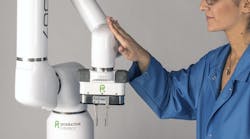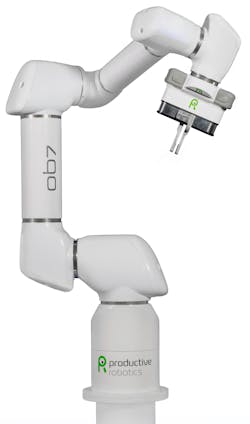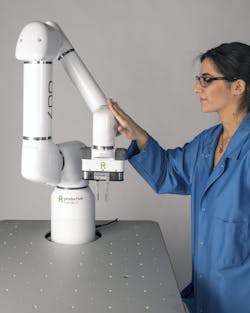Last month, we reported on Rethink Robotics closing its doors. The news came as a shock for many, as the company had been a staple in the robotics community for the last few years. Since then, the HAHN Group has acquired Rethink Robotics to rescue it from disappearing, but the impact has been felt. The engineering community will be looking to other robotic companies to step forward and take a more commanding presence.
Productive Robotics is introducing a new robotic arm, the OB7, a smart 7-axis collaborative robot which requires no direct programming to operate. The robotic arm is new to the world of cobots and is fully compliant with ISO 10218-1. We spoke with Zac Bogart, the company’s president, about the OB7 and the future of robotics.
The OB7 is the new cobot on the block and has an impressive seven movable joints.
Tell us a little about yourself, and a background on Productive Robotics.
I started in robotics in the early 1980s, designing robotic camera systems for special effects motion pictures. They were the most sophisticated camera systems in the industry at the time. They moved cameras and models of airplanes and spaceships through quite complex motions that had to look good, and natural, on screen. We learned how to make programming of complex motions simple enough for artists, not engineers.
My other company, ZBE Inc, expanded from automatic special effects and photography equipment into digital imaging. We’re a world leader now in high-end digital photo printers, with customers in 60 countries. Productive Robotics was formed in 2010 to resume our work in robotics. Our first product, OB7, embodies so much of what we learned and developed in the movie industry days—essentially, how you remove the programming from robots and make them simple enough for non-programming people to use them. “Easy to program” is not enough. It’s simplicity and ease of use for the operator that we’re focused on.
There are a lot of robotic arms on the market. What makes the OB7 different?
We say that you “teach” OB7, rather than programming it. The first and foremost differentiator is that there is no computer terminal-based programming involved using OB7. The operator simply “shows” OB7 the job: where to go to pick up objects, where to put them, how to open a door or push a button, even to communicate electronically with other machines. This allows a customer to easily move OB7 from job to job quickly and efficiently.
Another point that differentiates us from the majority of our competitors is that OB7 has seven moveable joints, while most collaborative robots have only six. Having seven moveable joints results in increased maneuverability and allows OB7 to better reach in and around the work area. For example, with seven joints we can put OB7 to the side of a work area and it can reach in, still allowing room for people. With six joints, the robot must be centered in the work area, dominating the space.
Zac Bogart is president of Productive Robotics and is bringing the OB7 to the cobot market.
What fields of industry are best suited for robotic development?
We look more at the specific application than the field of industry. Many unrelated fields have very similar processes. Of course, many types of manufacturing are already highly automated, so they are naturally suited for robotic development. However, the big opportunities for robotic development are in fields that have not yet become automated with robots, such as lower-volume food production, lower-volume and more-complex assembly tasks, more customized welding. Low volume applications are the common thread because it’s in these areas where industrial robot integration was previously deemed too costly to adopt. But things have changed considerably.
What do you feel is missing from the robotic market today? Is it a lack of robots deployed, lack of education amongst operators, etc.?
Education and simplicity: They go hand in hand. With regards to education, the manufacturing world is just not aware of what today’s collaborative robots are capable of. They either haven’t been exposed to collaborative robots or somehow think they’re a panacea because they’ve heard the hype. As for simplicity, you’ll hear a lot of talk from marketers that claim certain robots are “easy to program.” The problem is that when the customer gets the robot, they find out that it’s only “easy” if you're already a programmer. As long as robots need to be “programmed,” they won’t achieve the widespread use needed to reach the next tier of manufacturing, particularly in America. And that’s one of the things that sets OB7 apart from others in the market—the fact that users “teach” the robot rather than program it.
What industries do see the OB7 being used in the most?
OB7 can be, and is, used in many industries. It’s not so much the industry that OB7 serves, but the job it does to make businesses more efficient by addressing any labor shortages and freeing up employees to accomplish more value-added work. OB7 is currently used in product assembly, medical device manufacturing, CNC machine tending, injection molding, electronic product testing, plumbing fixture manufacturing, product printing, product packaging, and a few other unique applications.
For the OB7 to be classified as a cobot, it must be safe when it comes into contact with its human operators. The image above demonstrates how the OB7 will stop when it hits a hand.
How is the learning curve with OB7? Do you offer any training courses?
While the learning curve with OB7 is extremely short, we’re committed to providing the best customer service by offering training on-site or at our training facility, as well as tech support by phone or video. More often than not, our technical support staff is usually helping customers maximize the benefits of OB7 rather than how to use the robot.
With the sudden closure and acquisition of Rethink Robotics, how does your company see the robotic market and the future of Productive Robotics?
We see the market for Collaborative Robots as strong and growing, and Productive Robotics is well positioned to capitalize on this opportunity. The future for Productive Robotics is very bright. We are currently expanding very rapidly, growing our distribution network and hiring qualified individuals at all levels as fast as we can.




